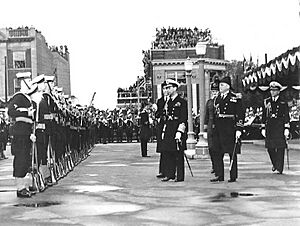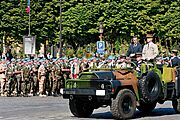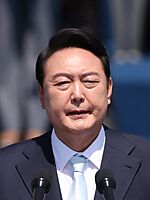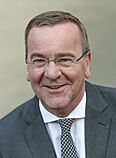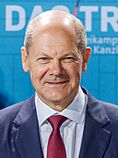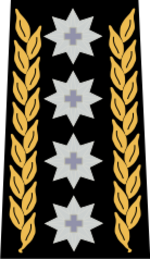Commander-in-chief facts for kids
A commander-in-chief is the top leader of a country's armed forces. This person has the highest power and control over the army, navy, and air force. Often, the commander-in-chief is the country's head of state (like a president or a king) or the head of government (like a prime minister). This role means they are in charge of making big decisions about the military.
Contents
What is a Commander-in-Chief?
The idea of a leader commanding all armed forces comes from ancient Rome. Roman leaders called Imperator had special powers over the military.
In English, the term "commander-in-chief" was first used during the English Civil War. Today, the head of state (a king, queen, or president) usually holds this title. Even if a different person, like a prime minister, handles the daily running of the government, the head of state often keeps this important military title. In some places, like colonies, the governor-general or colonial governor might also be the commander-in-chief for their area.
Sometimes, a commander-in-chief is also called a supreme commander. This term can also refer to a military officer who has a lot of power, usually under the head of state. It can also mean an officer in charge of one part of the military or a specific war zone.
Heads of State as Military Leaders
Many countries have their head of state as the commander-in-chief. This can be:
- A leader who makes all the big decisions, including military ones.
- A leader who is mostly ceremonial (like a king or queen in a constitutional monarchy). They have some power over the military, but usually act on the advice of the government.
Argentina
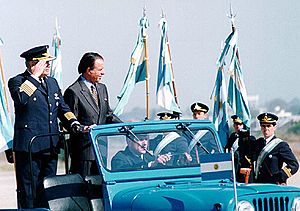
In Argentina, the president of the Argentine Nation is the "Commander-in-chief of all the armed forces". The president can also give military ranks to senior officers. They manage the military's organization and can declare war if the Argentine National Congress agrees. The Ministry of Defense helps the president manage the army, navy, and air force.
Australia
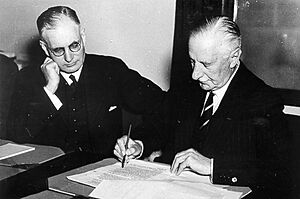
The Constitution of Australia says that the Governor-General is the commander-in-chief. This is because the Governor-General represents the King. However, in real life, the Governor-General does not actively command the military. The Australian Cabinet, led by the Prime Minister, controls the Australian Defence Force. The Minister for Defence manages the military day-to-day.
Bangladesh
The president is the commander-in-chief of the Bangladesh Armed Forces. But the prime minister has the main power and responsibility for national defense. The Ministry of Defence helps the prime minister with this.
Belarus
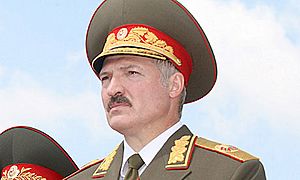
The president of Belarus is the Commander-in-Chief of the Belarusian Armed Forces. The president has a special uniform for this role. Article 28 of the Constitution of Belarus says the president can appoint and remove high-ranking military officers.
Brazil
The Brazilian Constitution states that the president is the supreme commander of the Brazilian Armed Forces.
Canada
In Canada, the Canadian monarch holds the powers of commander-in-chief. These powers are given to the Governor General of Canada, who also uses the title "Commander-in-Chief". The Governor General wears a special uniform for this role.
However, the prime minister and the Cabinet actually make the decisions about the armed forces. The Minister of National Defence is in charge of all matters related to national defense.
Denmark

The Danish monarch has traditionally been the head of the military. The constitution implies this, but the "King" in this context actually means the government. So, the government, led by the prime minister, has the main command authority. The Minister of Defence is the highest authority for defense. The Chief of Defence leads the military branches under the minister.
Egypt
In Egypt, the president has the ceremonial title of Supreme Commander of the Armed Forces. A government member, usually the defense minister, is the actual commander-in-chief. Only the president can declare war. Most Egyptian presidents have been former military officers.
Finland
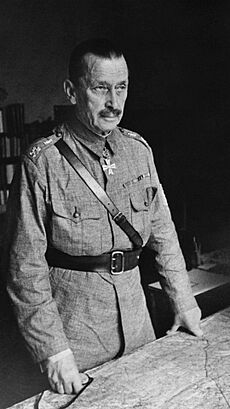
The president of Finland is the commander-in-chief of all Finnish military forces. The Chief of Defence handles the daily command. The Ministry of Defence manages the military's money. The president decides on big military defense plans and can activate reservists or mobilize the forces. If the Parliament is not meeting when a mobilization decision is made, it must be called together right away.
France
-
President Nicolas Sarkozy and General Jean-Louis Georgelin at the 2008 Bastille Day military parade in Paris.
-
Napoléon I reviewing his Imperial Guard in 1806.
In France, the President of the Republic is called the "Chief of the Armies." This means they are the top leader in military matters. The president also has strong emergency powers. However, the Prime Minister is responsible for national defense and can appoint people to military jobs.
India
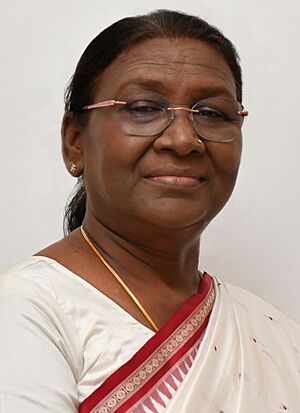
The Supreme Commander of the Indian Armed Forces is the president. This is stated in the Constitution of India. The president can declare war, but only with the approval of the Parliament of India. The president also appoints the leaders of each military branch, like the army, navy, and air force.
Even though the president is the official commander-in-chief, the prime minister and their ministers actually make the daily decisions. Since 2020, all three military chiefs report to the new Chief of Defence Staff.
Indonesia
The president of Indonesia is the supreme commander of the Indonesian National Armed Forces. The daily operations are handled by the Commander of the Armed Forces, a high-ranking officer. This commander is chosen by the president and must be approved by the House of Representatives. The minister of defense helps the president with defense issues and policies. To use military force or declare war, the president needs approval from the House of Representatives.
Iran
Before 1979, the Shah was the commander-in-chief in Iran. After the Islamic Republic was formed, the president of Iran first held this role. But later, the job of commander-in-chief of the Armed Forces of the Islamic Republic of Iran was given to the Supreme Leader of Iran.
Italy
The Constitution of Italy says that the President is the commander of the armed forces. The president is also the chairman of the supreme defense council. However, the Prime Minister and the government are responsible for national defense. The president declares war only after the parliament decides.
Japan
Before the Meiji Restoration, the shōgun was the commander-in-chief in Japan. After that, the Emperor of Japan held the role. Today, the emperor is a ceremonial figurehead and has no military role. The prime minister is now the commander-in-chief of the Japan Self-Defense Forces. Military decisions go from the prime minister to the Minister of Defense.
Mexico
The President of the United Mexican States is the "Supreme Commander of the Armed Forces." This includes the Army, Navy, and Air Force. The president uses these forces for national security and defense. The president can also appoint and remove the leaders of the Navy and National Defense.
New Zealand
The governor-general of New Zealand is the commander-in-chief. They are the top authority in defense matters. But in practice, this role is mostly ceremonial. The Governor-General acts on the advice of the Minister of Defence or other ministers. The Governor-General's powers are outlined in the Defence Act 1990.
Pakistan
In Pakistan, the President is the Commander-in-Chief of the Pakistan Armed Forces. Before 1973, the heads of the army, navy, and air force were called "Commander-in-Chief." After 1973, their titles changed to "Chief of Staff." The Prime Minister of Pakistan chooses these chiefs, and the president appoints them.
Philippines
The president of the Philippines is both the head of state and head of government. The 1987 Constitution says the president is the commander-in-chief of the Armed Forces.
Russia

The president is the Supreme Commander-in-Chief of the Armed Forces. The president approves military plans and appoints the defense minister and the chief of the general staff. The Russian Armed Forces include the Ground Forces, Navy, and Aerospace Forces, plus Strategic Missile Troops and Airborne Forces.
South Korea
The President of South Korea is the Commander-in-Chief and the top authority on all military matters.
Spain

The King of Spain exercises supreme command of the Armed Forces. The king often leads meetings of the National Security Council and military staff. All promotions in the military are made by a Royal decree signed by the king and the minister of defense.
However, all the king's official actions must be approved by the President of the Government or another minister. This prevents any single person from having too much power. The Government is responsible for defense. The chief of the defence staff is the professional head of the armed forces, working under the minister of defense.
Turkey

The President of Turkey represents the Supreme Military Command of the Turkish Armed Forces. The president can decide on military mobilization, appoint the chief of the general staff, and lead the National Security Council. They can also declare martial law or a state of emergency. These powers make the president the commander-in-chief of the nation.
United Kingdom
The British monarch is the "Head of the British Armed Forces" and is also called "Commander-in-Chief". The prime minister and the Cabinet make the main decisions on using the armed forces. The King remains the ceremonial "ultimate authority" of the military. Soldiers and officers swear loyalty to the monarch.
United States

The Constitution of the United States says the president of the United States is "Commander in Chief of the Army and Navy of the United States, and of the militia of the several States, when called into the actual Service of the United States." Since 1947, this means all United States Armed Forces. The president has the highest authority but does not hold a military rank. The exact amount of power the president has as commander-in-chief has been debated throughout history.
U.S. States
In U.S. States, the governor is also the commander-in-chief of their state's National Guard and other state forces. For example, in Kentucky, the Governor is the commander-in-chief of the state militia.
Venezuela

The president is the commander-in-chief of the Armed Forces. A law from 2008 made "comandante en jefe" a full military rank given to the president when they take office. The president receives special military items and a uniform to wear at military events.
Other Military Leaders
Armenia
The prime minister of Armenia is the Supreme Commander in Chief of the Armenian Armed Forces. The old title Sparapet was used for the supreme commander of ancient Armenian forces. Today, it describes famous military officials.
China
The Constitution of the People's Republic of China states that the Central Military Commission (CMC) has the authority to direct the military. The Chairman of the Central Military Commission is the Supreme Military Commander. This chairman is responsible to the National People's Congress.
The president of the People's Republic of China can declare martial law, a state of war, and issue mobilization orders. Since 1993, the president, the CMC chairman, and the Communist Party's general secretary are usually the same person.
Hong Kong
When Hong Kong was under British rule, the civilian governor was the commander-in-chief. After 1997, the commanders of the People's Liberation Army Hong Kong Garrison are from mainland China and are commanded by the CMC.
Germany
- Federal Republic of Germany (1956–present)

In West Germany, after the military was re-established in 1955, the Basic Law for the Federal Republic of Germany was changed. In peacetime, the federal minister of defence has the supreme command over the Bundeswehr. If the Bundestag (German parliament) declares a state of defense, the Federal Chancellor takes command. The president of Germany has no role in commanding the forces, but receives ceremonial honors.
This system is different from older German traditions where the head of state commanded the military. It ensures that the military is always under the control of the parliament in a democratic system.
- German Reich (1871–1945)
During the German Empire, Weimar Republic, and Nazi era, the head of state (like the German emperor or president) was the head of the Armed Forces. Each military branch had its own head who reported directly to the head of state.
After Adolf Hitler became Führer in 1934, he later took personal command of the Armed Forces in 1938.
Israel
In Israel, the Government of Israel (led by the prime minister) has the ultimate authority over the Israel Defense Forces. The minister of defense exercises this authority. However, the chief of general staff is the commander-in-chief of the IDF and holds the highest military command, reporting to the minister of defense.
Myanmar

In Myanmar, the Commander-in-Chief of Defence Services is a military officer, not the president. This commander is part of the National Defence and Security Council and reports to the president.
Netherlands
The Constitution of the Netherlands says that "the Government shall have supreme authority over the armed forces". The "Government" includes the Monarch and the ministers. Only ministers are responsible for government actions. The minister of defence has the main responsibility for the armed forces. The chief of defence is the highest-ranked military officer and works between the minister and the armed forces.
North Korea
The President of the State Affairs Commission is the supreme leader of North Korea and the commander-in-chief of the armed forces. Since 2018, Kim Jong-un issues orders for the Korean People's Army in the name of the Chairman of the Central Military Commission of the Workers' Party of Korea.
Sweden
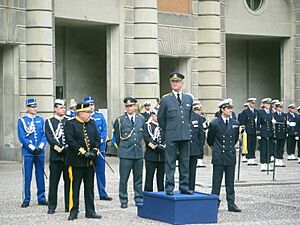
In Sweden, the monarch used to be the commander-in-chief. But with the Instrument of Government of 1974, the Government (led by the prime minister) now holds the highest power. The minister for defence handles many decisions about the Armed Forces.
The head of the Swedish Armed Forces agency is called the supreme commander. The Monarch (King Carl XVI Gustaf) is still a four-star general and admiral à la suite and is seen as the main representative of the Swedish Armed Forces.
Switzerland
The Federal Council (the Swiss head of state) has supreme authority over the military. However, the Federal Council can only command a small number of soldiers (up to 4,000) for a short time (three weeks). To use more soldiers, the Federal Assembly must elect a General. This General becomes the commander-in-chief during war or a national emergency.
In peacetime, the Armed Forces are led by the Chief of the Armed Forces. Switzerland has only appointed a General four times in its history, during major conflicts like the World Wars, even though it remained neutral.
Images for kids
-
Chairman of the Presidency of Bosnia and Herzegovina Alija Izetbegović (right) meeting with US president Bill Clinton (left) in 1997.
-
President Droupadi Murmu (2022).
See also
 In Spanish: Comandante en jefe para niños
In Spanish: Comandante en jefe para niños- Civilian control of the military
- Command and control
- Commanding officer
- Defence minister
- Generalissimo
- Military junta
- Strongman (politics)
- Supreme Commander (disambiguation)
- Warlord


